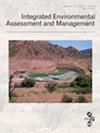Jonathan Michael Petali, Erin L. Pulster, Christopher McCarthy, Heidi M. Pickard, Elsie M. Sunderland, Jacqueline Bangma, Courtney C. Carignan, Anna Robuck, Kathryn A. Crawford, Megan E. Romano, Rainer Lohmann, Katherine von Stackelburg
下载PDF
{"title":"支持全氟烷基和多氟烷基物质鱼类消费建议的科学和传播方面的考虑因素和挑战。","authors":"Jonathan Michael Petali, Erin L. Pulster, Christopher McCarthy, Heidi M. Pickard, Elsie M. Sunderland, Jacqueline Bangma, Courtney C. Carignan, Anna Robuck, Kathryn A. Crawford, Megan E. Romano, Rainer Lohmann, Katherine von Stackelburg","doi":"10.1002/ieam.4947","DOIUrl":null,"url":null,"abstract":"<p>Federal, state, tribal, or local entities in the United States issue fish consumption advisories (FCAs) as guidance for safer consumption of locally caught fish containing contaminants. Fish consumption advisories have been developed for commonly detected compounds such as mercury and polychlorinated biphenyls. The existing national guidance does not specifically address the unique challenges associated with bioaccumulation and consumption risk related to per- and polyfluoroalkyl substances (PFAS). As a result, several states have derived their own PFAS-related consumption guidelines, many of which focus on one frequently detected PFAS, known as perfluorooctane sulfonic acid (PFOS). However, there can be significant variation between tissue concentrations or trigger concentrations (TCs) of PFOS that support the individual state-issued FCAs. This variation in TCs can create challenges for risk assessors and risk communicators in their efforts to protect public health. The objective of this article is to review existing challenges, knowledge gaps, and needs related to issuing PFAS-related FCAs and to provide key considerations for the development of protective fish consumption guidance. The current state of the science and variability in FCA derivation, considerations for sampling and analytical methodologies, risk management, risk communication, and policy challenges are discussed. How to best address PFAS mixtures in the development of FCAs, in risk assessment, and establishment of effect thresholds remains a major challenge, as well as a source of uncertainty and scrutiny. This includes developments better elucidating toxicity factors, exposures to PFAS mixtures, community fish consumption behaviors, and evolving technology and analytical instrumentation, methods, and the associated detection limits. Given the evolving science and public interests informing PFAS-related FCAs, continued review and revision of FCA approaches and best practices are vital. Nonetheless, consistent, widely applicable, PFAS-specific approaches informing methods, critical concentration thresholds, and priority compounds may assist practitioners in PFAS-related FCA development and possibly reduce variability between states and jurisdictions. <i>Integr Environ Assess Manag</i> 2024;20:1839–1858. © 2024 The Author(s). <i>Integrated Environmental Assessment and Management</i> published by Wiley Periodicals LLC on behalf of Society of Environmental Toxicology & Chemistry (SETAC).</p>","PeriodicalId":13557,"journal":{"name":"Integrated Environmental Assessment and Management","volume":null,"pages":null},"PeriodicalIF":3.0000,"publicationDate":"2024-05-16","publicationTypes":"Journal Article","fieldsOfStudy":null,"isOpenAccess":false,"openAccessPdf":"https://onlinelibrary.wiley.com/doi/epdf/10.1002/ieam.4947","citationCount":"0","resultStr":"{\"title\":\"Considerations and challenges in support of science and communication of fish consumption advisories for per- and polyfluoroalkyl substances\",\"authors\":\"Jonathan Michael Petali, Erin L. Pulster, Christopher McCarthy, Heidi M. Pickard, Elsie M. Sunderland, Jacqueline Bangma, Courtney C. Carignan, Anna Robuck, Kathryn A. Crawford, Megan E. Romano, Rainer Lohmann, Katherine von Stackelburg\",\"doi\":\"10.1002/ieam.4947\",\"DOIUrl\":null,\"url\":null,\"abstract\":\"<p>Federal, state, tribal, or local entities in the United States issue fish consumption advisories (FCAs) as guidance for safer consumption of locally caught fish containing contaminants. Fish consumption advisories have been developed for commonly detected compounds such as mercury and polychlorinated biphenyls. The existing national guidance does not specifically address the unique challenges associated with bioaccumulation and consumption risk related to per- and polyfluoroalkyl substances (PFAS). As a result, several states have derived their own PFAS-related consumption guidelines, many of which focus on one frequently detected PFAS, known as perfluorooctane sulfonic acid (PFOS). However, there can be significant variation between tissue concentrations or trigger concentrations (TCs) of PFOS that support the individual state-issued FCAs. This variation in TCs can create challenges for risk assessors and risk communicators in their efforts to protect public health. The objective of this article is to review existing challenges, knowledge gaps, and needs related to issuing PFAS-related FCAs and to provide key considerations for the development of protective fish consumption guidance. The current state of the science and variability in FCA derivation, considerations for sampling and analytical methodologies, risk management, risk communication, and policy challenges are discussed. How to best address PFAS mixtures in the development of FCAs, in risk assessment, and establishment of effect thresholds remains a major challenge, as well as a source of uncertainty and scrutiny. This includes developments better elucidating toxicity factors, exposures to PFAS mixtures, community fish consumption behaviors, and evolving technology and analytical instrumentation, methods, and the associated detection limits. Given the evolving science and public interests informing PFAS-related FCAs, continued review and revision of FCA approaches and best practices are vital. Nonetheless, consistent, widely applicable, PFAS-specific approaches informing methods, critical concentration thresholds, and priority compounds may assist practitioners in PFAS-related FCA development and possibly reduce variability between states and jurisdictions. <i>Integr Environ Assess Manag</i> 2024;20:1839–1858. © 2024 The Author(s). <i>Integrated Environmental Assessment and Management</i> published by Wiley Periodicals LLC on behalf of Society of Environmental Toxicology & Chemistry (SETAC).</p>\",\"PeriodicalId\":13557,\"journal\":{\"name\":\"Integrated Environmental Assessment and Management\",\"volume\":null,\"pages\":null},\"PeriodicalIF\":3.0000,\"publicationDate\":\"2024-05-16\",\"publicationTypes\":\"Journal Article\",\"fieldsOfStudy\":null,\"isOpenAccess\":false,\"openAccessPdf\":\"https://onlinelibrary.wiley.com/doi/epdf/10.1002/ieam.4947\",\"citationCount\":\"0\",\"resultStr\":null,\"platform\":\"Semanticscholar\",\"paperid\":null,\"PeriodicalName\":\"Integrated Environmental Assessment and Management\",\"FirstCategoryId\":\"93\",\"ListUrlMain\":\"https://onlinelibrary.wiley.com/doi/10.1002/ieam.4947\",\"RegionNum\":4,\"RegionCategory\":\"环境科学与生态学\",\"ArticlePicture\":[],\"TitleCN\":null,\"AbstractTextCN\":null,\"PMCID\":null,\"EPubDate\":\"\",\"PubModel\":\"\",\"JCR\":\"Q2\",\"JCRName\":\"ENVIRONMENTAL SCIENCES\",\"Score\":null,\"Total\":0}","platform":"Semanticscholar","paperid":null,"PeriodicalName":"Integrated Environmental Assessment and Management","FirstCategoryId":"93","ListUrlMain":"https://onlinelibrary.wiley.com/doi/10.1002/ieam.4947","RegionNum":4,"RegionCategory":"环境科学与生态学","ArticlePicture":[],"TitleCN":null,"AbstractTextCN":null,"PMCID":null,"EPubDate":"","PubModel":"","JCR":"Q2","JCRName":"ENVIRONMENTAL SCIENCES","Score":null,"Total":0}
引用次数: 0
引用
批量引用


 求助内容:
求助内容: 应助结果提醒方式:
应助结果提醒方式:


